Tagged with 'Events'


-
The Glamour of Italian Fashion
The Glamour of Italian Fashion
Opening this weekend is the V&A's major Spring show, 'The Glamour of Italian Fashion 1945-2104'.
Charting the rise of Italian fashion over the last 70 years, the exhibition follows the pivotal events, production innovations and individuals that have created an industry feted today for its glamour, sophistication and luxury.
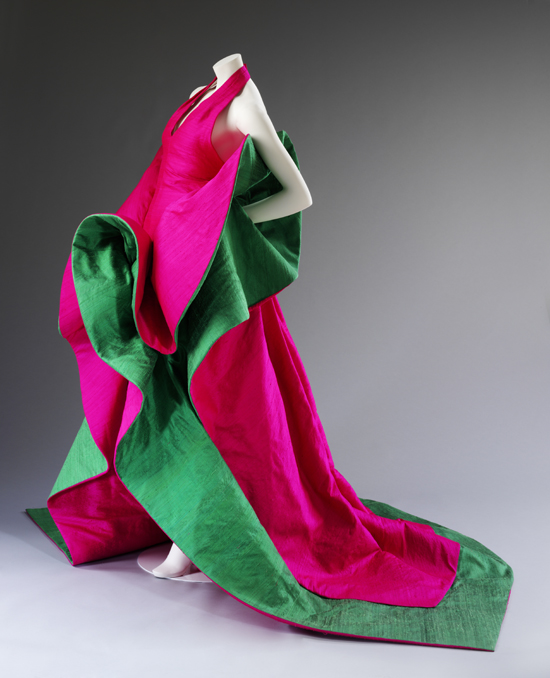
The curator of the exhibition, Sonnet Stanfill who is also curator of 20th century and contemporary fashion at the V&A, has drawn together over 100 ensembles and accessories by many of Italy's famous fashion houses.
Visitors to the exhibition can admire the elegance and seductive style of Valentino, Prada and Armani, the intricacy of knitwear by Missoni, and fine leatherwork by Dolce & Gabbana and Gucci.

For jewellery lovers there will also be a rare opportunity to view the sheer opulence of a private collection of Bulgari jewels.
As more films were being shot on location in Italy during the 1950s and 1960s, Hollywood stars such as Audrey Hepburn and Elizabeth Taylor became style icons for Italian fashion. The American market, in particular, began to take note.
Taylor's husband Richard Burton even famously quipped 'the only word Liz knows in Italian is Bulgari'.
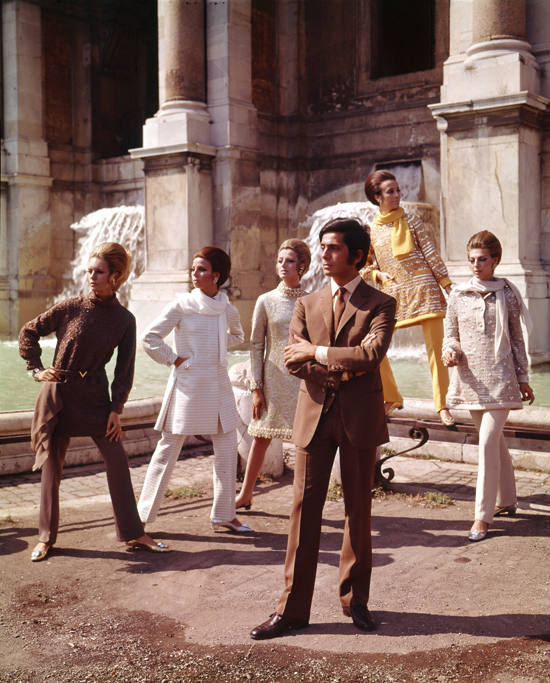
Rather than just being an amazing roll call of today's international design labels, the exhibition also offers the visitor a unique perspective in its examination of these early years.
In preparing the exhibition, Curator Stanfill has carefully researched the world of the Sala Bianca, pictured above, which is often regarded as the post-war birthplace of Italian fashion.
The Sala Bianca was the dream of an Italian business man called Giovanni Battista Giorgini who, whilst exporting Italian-made luxury goods to America, saw an opportunity to promote Italian artisanship and style. A gentleman, without profiting personally from the initiative, Giorgini was also a marketing genius.
Hiring crystal chandeliers, catwalk models and the surroundings of the famous Pitti Palace in Firenze, Giorgini introduced the Italian fashion industry to the world within just a few successful seasons.
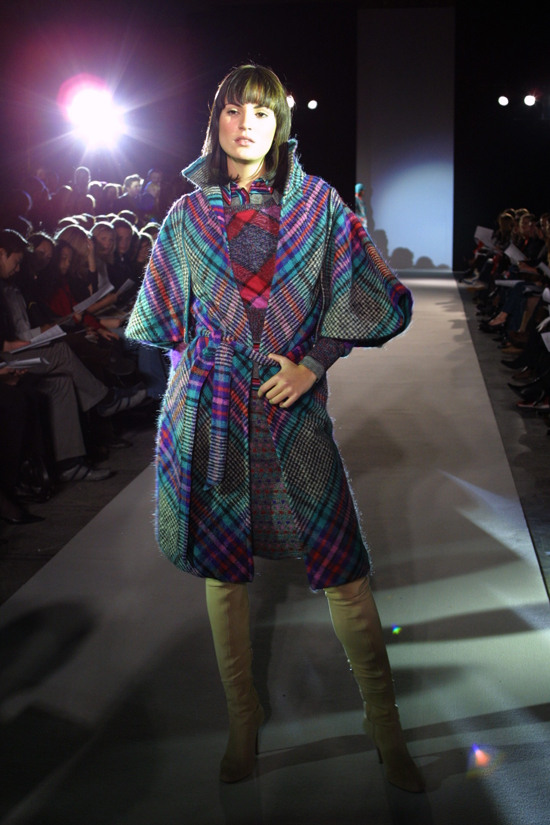
The exhibition finishes with a video debate on the future of Italian fashion and questions its role in a world of overseas production and fast-fashion.
Promising to be a thought-provoking and affectionate look at the status of 'Made in Italy' today, the 'Glamour of Italian Fashion 1945-2014' opens on 5th April until 27 July 2014 at the V&A, London.
-
Mystery Surrounds The Cheapside Hoard
Mystery Surrounds The Cheapside Hoard
Mystery still surrounds the jewels of the Cheapside Hoard. Why were these striking jewels originally buried deep beneath the cellar of a building in London's Cheapside and what was the purpose of many of the objects that the Hoard contained?
The Cheapside Hoard was discovered in 1912, the most significant find of its kind, during the redevelopment of Cheapside, a medieval street between modern day St. Paul's Cathedral and Bank. This bustling market route was famously described by Charles Dickens Jr. as "the greatest thoroughfare in the City of London".

The exhibition's curators can be relatively accurate about the date that the Cheapside Hoard was originally buried. The particular style of the jewels and the date of the Great Fire of London that flattened much of the area around Cheapside, bookends the Hoard being buried during a decade that was approximately between 1650-1666.

Given the repetition of a number of similar styles and ideas throughout the collection - numerous carved grapes in amethyst and emerald, ropes of enamelled floral chains - it does seem that the owner might have been a jeweller or dealer, perhaps from nearby Goldsmiths' Row. The Hoard clearly pinpoints the fashions of the day in a way that the collection of an individual might not.

Currently on show at the Museum of London in its entirety for the first time in a century, there are just a few pearls in the Hoard that have survived the four hundred years since the pieces were first hidden away. The myriad empty settings that remain - the curators estimate approximately 1,386 were intended for pearls - are testament to the gem's enduring appeal.
Of those on display, the pieces crafted from fine gold wirework, encasing sheets of back-to-back mother of pearl (most now sadly lost), are captivating. Designed in the shape of what the curators describe as "the translucent seed pods of the plant Lunaria, regarded as a symbol of honesty and appreciated for its healing properties," it is not clear that the items were ever intended for wear.

Mother of pearl was more commonly found in inlay work at this time, and the scale of the pieces precludes them being worn as earrings. However, the enamelled four-petalled cross that links the fifth drop to the main four petals would have given the gems a lovely movement, and had the mother of pearl itself been engraved, as the curators suggest the material often was, these pieces would have been quite beguiling.
The combination of enamel and seed pearls (a chain of which in the Hoard has settings for over 500 pearls with only 7 remaining) was popular in London at this time, a trend which Winterson's Beau collection designed by Alice Cicolini in some part echoes.
Seed pearls also appear on delicate wirework buttons that would have required a high level of craftsmanship for these to be realised.
Of the striking pearls of the Cheapside Hoard that have survived the centuries, the most notable are a baroque pearl carved into the shape of a ship, complete with wirework mast and rigging, and an 11mm pearl with a deep "orient lustre" that sits above a figuratively carved sapphire.

As with many other gems, a pearl of "oriental origin" commanded a high price during the period, the term being used to imply quality as much as provenance. Londoners in the 1600s, the curators believe, were particularly fussy about the quality of their pearls, with even high grade pearls going unsold if they were not of the correct colour and radiant lustre.
At Winterson, where great care is also taken to identify the finest quality pearls to make up our jewellery, we tend to agree!
The Cheapside Hoard: London's Lost Jewels is exhibiting at the Museum of London until 27th April.
-
The Friday Late Rules of Adornment
The Friday Late Rules of Adornment
The regular Friday Late event at the V&A this week features The Rules of Adornment, an evening of workshops, films and performances exploring the question of why we choose to wear what we do.
Inspired by the V&A and Qatar Museums Authority's current Pearls exhibition, this popular regular event promises to mix guest DJs with fashion and graphic design, as well as presentations and installations on music, tattoos and jewellery.

Amongst the events exploring the links between adornment, status and personal expression are a number that are related to pearls. Here is our selection:
18.30-21.30, a drawing-based workshop by artist Ben Barbour on the history of the pearl trade routes;
19.00-20.00, Pearl Editions by students at Central Saint Martins. As a follow-up to their Pearl Variations project, BA Jewellery students from CSM have created a series of limited edition collections for the evening that pushes the possibilities of pearls as adornment;
20.00, a conversation by Pearls curator Beatriz Chadour-Sampson and Qatar National Museum Heritage expert Dr Najla Ismail into the myths, symbolism and fashion of pearls.
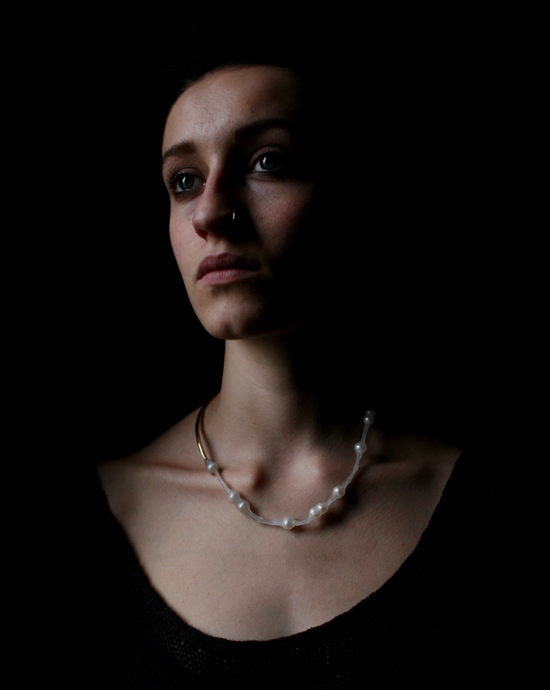
There are many other events during the evening in the main hall and throughout the museum itself. Or if you would like to acquire a hand-drawn tattoo, or even to learn how King George V acquired his, then this is the event for you.
The Museum is open late to the public on Friday 29th November until 22.00. All Friday Late events are free, although some places may be ticketed on a first come first served basis.
-
The CSM Pearl Variations Project At The V&A
The CSM Pearl Variations Project At The V&A
Earlier this year, we were privileged to take part in Pearl Variations, a collaborative project between the first year BA Jewellery students at Central Saint Martins (CSM) and the Victoria and Albert Museum, London.
To coincide with the opening of the V&A and the Qatar Museums Authority Exhibition on Pearls, the students were invited to explore the history of this gem and the possibilities that new ideas and creativity might bring to pearl jewellery design.
Each student was encouraged to produce a collection or theme of work, with the opportunity for three pieces to be selected for sale in the V&A Shop - an exciting prospect for any aspiring jewellery designer!
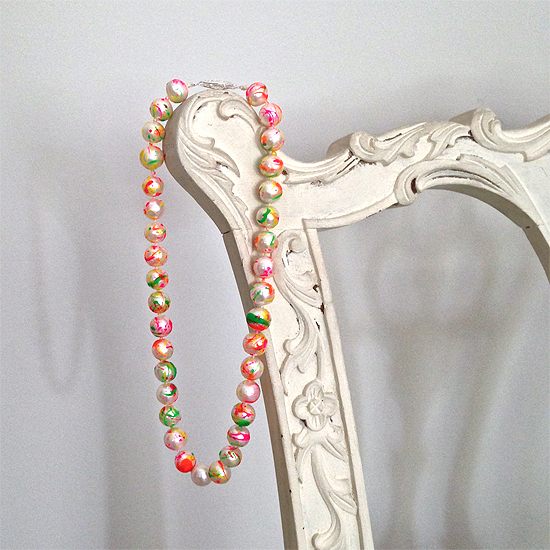
Following an introduction to the exhibition by one of its curators Beatriz Chadour-Sampson, the students embarked on developing their ideas.
Alongside a senior buyer from the V&A, we attended two reviews in March and June to give some specialist pearl feedback on the work-in-progress.
Looking back at the notes from those sessions, it is fantastic to see how the students' work progressed throughout the project.
Lili Murphy Johnson's Brace-let (pictured above) was inspired by the phrase 'pearly white teeth'. The original design using orthodontic steel braces and pearls to give the impression of a dental brace of real teeth was carried through brilliantly.
There were many other stand-out ideas in the group. Harriet Williams' vibrantly painted pearls (also above) played with notions of value and colour, whilst Danya Xie's ebony pearl ring was one of our favourites. An elegant contrast of materials, colour and texture created a ring that would be endlessly turned on the wearer's finger.

During the period of the exhibition until 19 January 2014, each of the pieces above are on sale in person and online at the V&A Shop.
Our thanks go to the students, Giles Last at CSM and the V&A for the realisation of this unique project.
-
Laura Whitmore at the V&A Pearls Exhibition
Laura Whitmore at the V&A Pearls Exhibition
Laura Whitmore, brand ambassador at Pond's Institute and immaculate host of ITV2's 'I'm A Celebrity, Get Me Out of Here! Now!', last week hosted an exclusive event for 100 press and VIPs at the Victoria & Albert Museum's Pearls Exhibition.
We were delighted to be asked to help celebrate the event with Laura wearing a selection from our finest Akoya pearl range of jewellery.
The Akoya pearl is a traditional type of saltwater pearl, that is cultured in oysters in coastal waters near Japan, China and Vietnam. The Akoya is particularly well-known for its sharp lustre, perfect round shape and tinted pink overtone.
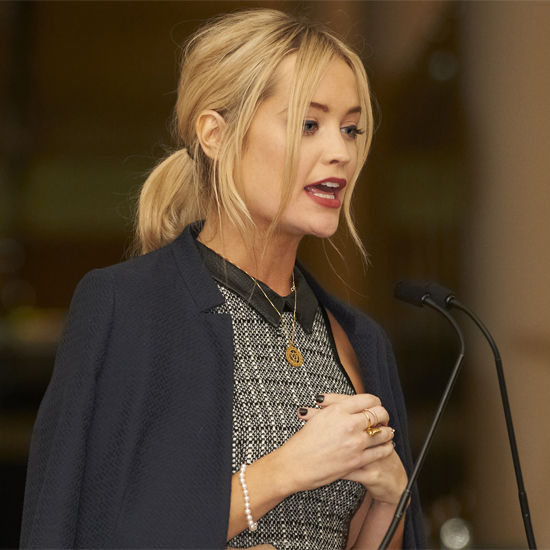
The guests were treated to an interview by Laura Whitmore about Pond's and pearls with Caroline Neville, followed by a private tour of the Pearl Exhibition to see the pieces on display there and learn about the iconic status that this amazing gem has held throughout history.
The pearl jewellery on show included Marilyn Monroe's necklace of Akoya pearls, which was famously bought for her in Japan by her husband Joe DiMaggio in 1954, and a pair of Bulgari pearl drop pendant earrings worn by Elizabeth Taylor.
An explanation of how pearls are cultured today introduced a number of showcase pieces of Akoya pearl jewellery by Mikimoto, including a flamboyant scarf of over 5000 pearls that was just pure showbiz.
As well as the elegant Akoya Pearl Bracelet, pictured below, Laura also wore our Amber Eclipse Pearl Ring which is an open ring design of 18 carat yellow gold, that has been finished with a square-cut orange sapphire gemstone set facing a white Akoya pearl.

Laura also wore our new Beau Seed Pearl and Diamond Ring with Yellow Gold, designed by Alice Cicolini. With seed pearls, a diamond knot and a flamboyant bow, this eye-catching ring will be coming soon to Winterson with the launch of Alice's Beau Collection.
Thank you to Laura Whitmore and Pond's Institute for hosting the event.
-
SS14 Jewellery and Pearls at the Rock Vault
SS14 Jewellery and Pearls at the Rock Vault
With September quickly fading into the Autumn, we look back to some of the SS14 jewellery and pearls that excited our attention this season at London Fashion Week.
Rock Vault, curated by jeweller Stephen Webster, is a showcase of ten of the most talented designers working in the UK. The initiative is into its fourth season and a perfect opportunity for press and buyers alike to see the group's new collections.
ALICE CICOLINI
Alice Cicolini's colourful new Kimono Collection, explores traditional patterns within circles and using her trademark enamelling techniques. The Kimono pieces mix vitreous enamel with vintage hand cut diamonds, polished opals and some truly fabulous pearls!

Our forthcoming Beau collection with Alice Cicolini, was also on show for the first time. We are very excited to be launching it at Winterson soon.
MELANIE GEORGACOPOULOS
Contemporary designer Melanie Georgacopoulos is admired for challenging traditional notions of what pearls mean in today's world.
Her previous work has included splitting cultured pearls in half to reveal the concentric layers of nacre inside and drilling pearls from the inside out to leave a skeletal shell of its surface.
Previewing her new SS14 for M/G Tasaki, a collaboration with the Japanese fine jeweller, Melanie's collection featured white Freshwater pearls and stretched 18 carat gold chain. We loved the inventiveness of this ring.
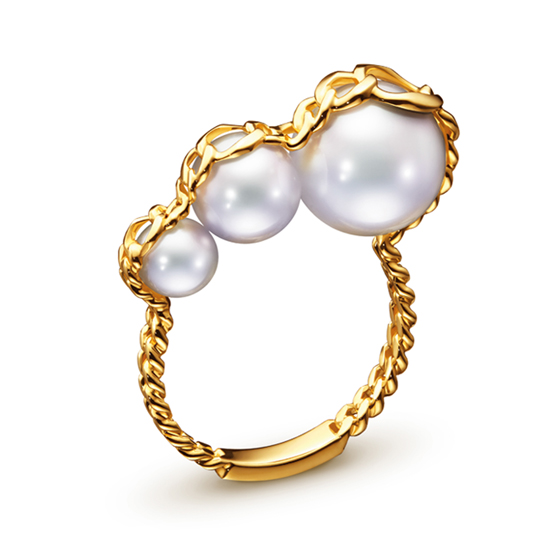
Also on show was Melanie's new fine jewellery line of necklaces, pendants and earrings, exploring the relationship between pearls and diamonds that have been set in cages of 18 carat gold.
ORNELLA IANNUZZI
A welcome addition to the Rock Vault this September was Ornella Iannuzzi's coral fantasy pieces, which set a variety of colourful Freshwater and Tahitian pearls in gold and silver forms that have been inspired by nature.
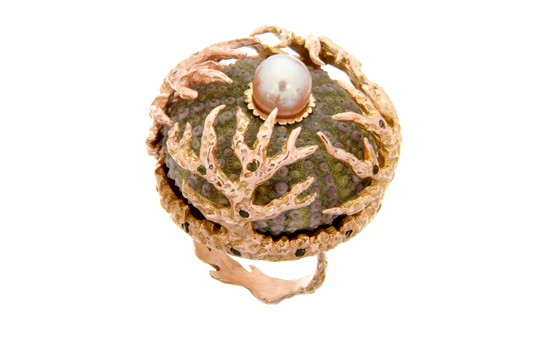
Ornella Iannuzzi is best known for her sculptural, organic jewellery that is created by hand in her London studio, such as the fabulous Abyss ring above.
Launching at LFW for SS14 was Les Corallines, a new everyday wear range that continued the volcanic, underwater theme with silver and gold vermeil pieces and these baroque saltwater Tahitian pearls.
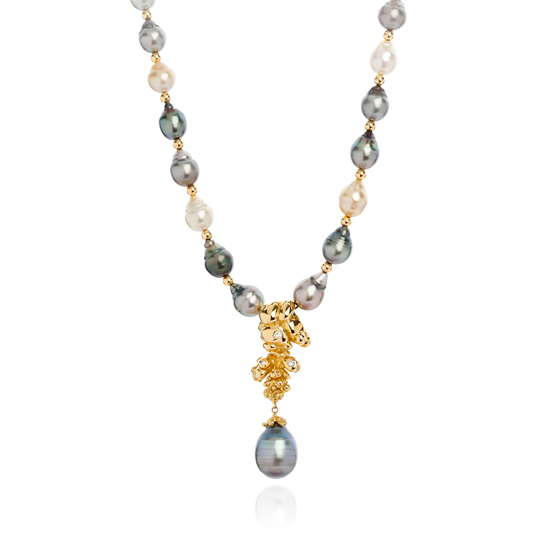
-
Pearls Exhibition at the V&A Museum
Pearls Exhibition at the V&A Museum
With much excitement and anticipation, the Pearls exhibition at the V&A Museum opens later this month in London.
PEARLS EXHIBITION AT THE V&A
Promising to be one of the biggest Autumn shows, the exhibition will show off the luxurious qualities of some of the world's most unusual and valuable pearls and jewellery, as well as exploring the unique heritage and impact on popular culture of this beautiful gem.
We are very fortunate to be able to ask Beatriz Chadour-Sampson and Hubert Bari, the curators of the Pearls exhibition, about the show and what a visitor can look forward to. We would like to thank them, the V&A and the Qatar Museums Authority for their support with this article.
Here are Beatriz and Hubert's thoughts on 'Pearls'.
How special has this exhibition been for you and to curate? What did you hope that its visitors may learn about pearls?
From all gems, it is the most unusual as the natural pearl is produced by living animals. Even cultured pearls after human intervention are created by nature. Visitors will be amazed to learn that, in principle, any mollusc can produce a pearl from the giant clam to the land snail, and they will be dazzled by the variety of shapes and colours of pearls.
The history of the trade of pearls between continents is fascinating, and how East and West share the same passion for pearls.
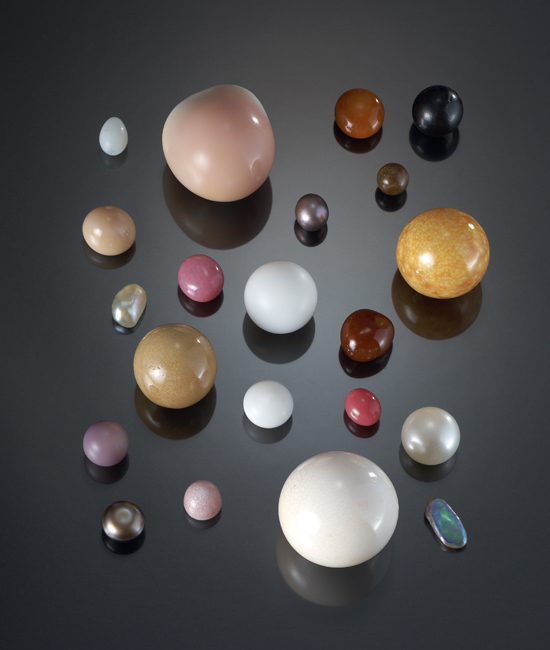
Pearls have a unique symbolic significance and mystique. Can the pearl claim to be the world's favourite gem?
Incredibly, pearls have created a global fascination over millennia, like no other gem. There is something magical about pearls, their beauty lies in their perfection of form and most of all lustre. They are born in the form that nature made them with a natural sheen.
Pearls have always been a symbol of femininity. Maybe this is the reason why the fashion for pearls continues today.

The exhibition showcases many famous examples of pearl jewellery, many styles of which are still being referenced today in popular culture. Have we already seen a 'golden age' of pearl jewellery design or is the pearl a gem that will be constantly reinvented?
Yes, as no other gem has been worn as consistently, as pearls. Pearls are neutral and versatile, appropriate for any occasion. In previous years jewellers have shown a persistent, if not renewed interest in creating new designs with pearls.

What is the most striking or surprising aspect for you about the history of the pearl?
The fascination for pearls and wish to wear these beauties of nature transcends cultures and borders. The similarities in the myths and legends surrounding the pearl in East and West are astonishing. Pearls mark authority and power, symbolize prosperity and on a more personal note they are associated with joy at weddings or tears as a sign of mourning.

Natural pearls have undergone a renaissance in the last decade, achieving spectacular prices at auction, and cultured pearls are being produced in better, more diverse and beautiful qualities. What does the future hold for this gem?
The future of the pearl depends on so many factors, not least the condition of our seas. Natural pearls are simply too rare and expensive, only affordable to the very few. Today China produces such quantities of cultured pearls of inferior quality, that they are endangering the pearl market. Whilst they give great care when creating one pearl from an oyster, the Chinese produce 50 in one mussel, at low cost in rice fields or near housing estates. In South East Asia the farms which produce the beautiful South Sea pearls are experiencing not only financial difficulties but the effects of pollution and for these reasons their future remains uncertain.
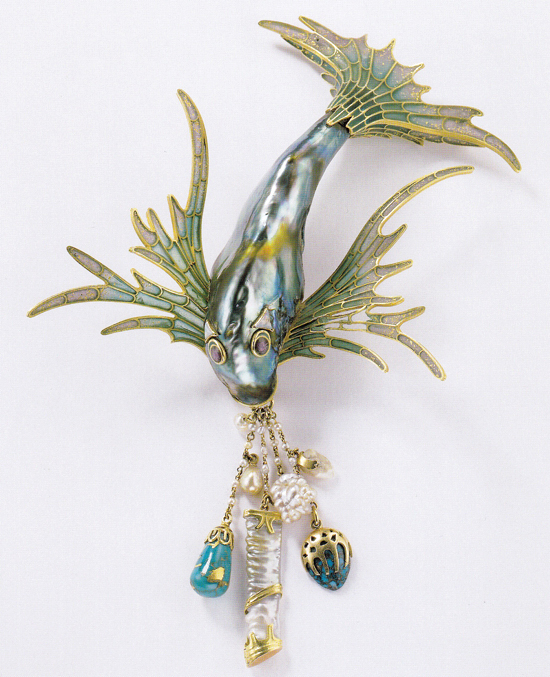
The desire for pearls has been so insatiable that imitation pearls have existed over centuries and their advocate in the 1930s Coco Chanel was instrumental in reviving the fashion for pearls and revived the industry at a time when this was unthinkable. No one can tell what the future will hold for this beautiful gem, but the fashion for pearls endures.
The 'Pearls, V&A and Qatar Museums Authority Exhibition', runs from 21 September 2013 to 19 January 2014 as part of the Qatar UK 2013 Year of Culture.
To learn more about the exhibition, visit the V&A website here.
-
CSM Jewellery 2013 - The Designers Part II
CSM Jewellery 2013 - The Designers Part II
The second in a two part series of short interviews with designers from the CSM Jewellery 2013 show features Natha Khunprasert, Ruth Mackin, Sarah Ysabel Dyne Narici and Xue Dong.
Read about some of the other designers in Part I of our interviews here.
NATHA KHUNPRASERT

Tell us a bit about yourself.
I grew up wanting to be a fashion designer, and then find my interest in product design to then ultimately realise my true passion lies within jewellery designing and making. I enjoy injecting kitsch element into my work.
What was the inspiration for this piece?
The initial inspiration of my collection projected from my personal interest in the beauty and function of nails, as personal expression of style and extension of our bodies. The project developed into not only the jewellery for nails but instead, jewellery about ‘Fingertips’, where they play significant roles in our lives.
Who is your favourite designer or artist and why?
Melanie Georgacopoulos: I truly admire her ability to give an edge and a more youthful & playful aesthetic to the timeless value of pearls, as well as her talent in creating both equally exciting smaller pieces and big show pieces.
What’s your motto?
“Live life to the fullest”
RUTH MACKIN
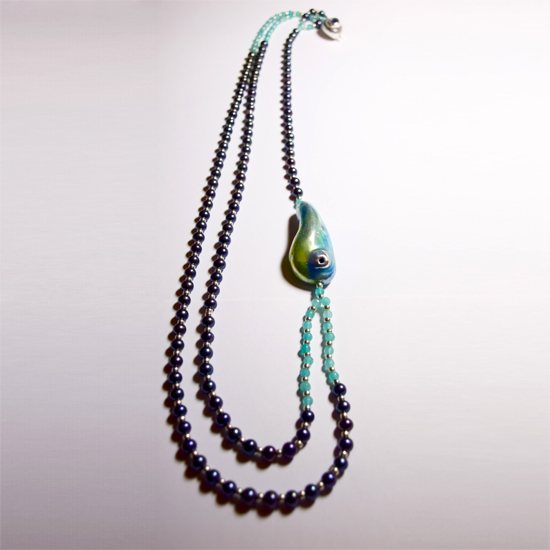
Tell us a bit about yourself.
My name is Ruth Mackin and I was born in Vanuatu in the South Pacific. My family and I later moved to the Cayman Islands returning to Britain for my secondary education. Arts Foundation was great fun at Chesterfield College, then on to CSM. I love creating miniature detail in my creative work and hope this shows through in my design process.
What was the inspiration for this piece?
Fond memories of tropical seas and the brilliant colours of the ocean. Even now watching the ebb and flow of the tides as they sweep through rock pools. Feeding sea anemones tiny scraps of fish.
What’s next for you?
I spent a very varied and exciting internship between second and third year working for Hannah Martin (London) and various other companies. Now I want to successfully complete my degree and move forward with designing collections within a company, perhaps one with connections on the continent, hence the French lessons.
Name one jewellery toolbox essential that you can’t live without.
My paints and paint brushes.
SARAH YSABEL DYNE NARICI

Tell us a bit about yourself.
I am a half Italian, half British twenty-two year old female. I grew up in Milan until I was nine years old… I have been studying jewellery design at CSM for three years and am ready for the next chapter of my life to commence!
What was the inspiration for this piece?
The collection is designed for a future society, living outside of planet Earth’s parameters in the year 2050. The pearls in these pieces have been encapsulated into individual acrylic blocks in a nostalgic act of celebration of the natural wonders of the Earth.
What’s next for you?
After I graduate I plan on moving to Paris to expand my knowledge of design in a fine jewellery house.
What do you like most about pearls?
The stunning and subtle array of colours that you can see on closer inspection.
What has been your best experience or moment at CSM?
Difficult to answer there have been many! Finding a path that I enjoy so much is probably the best feeling and experience I have had.
Who is your favourite designer or artist and why?
This is difficult to answer as I have many, however one of my favourites is the Belgian multidisciplinary artist, Jan Fabre. I think he is one of the most exciting contemporary artists and his work both in theatre and sculptures always prompts question and thought.
If you were a gemstone, what would you be?
An opal.
Name one jewellery toolbox essential that you can’t live without.
My file.
What’s your motto?
"Audentior ito"
XUE DONG

Tell us a bit about yourself.
I think jewelry is like small sculptures. I am interested in making jewelry, which is delicate with less formally structured shapes.
What was the inspiration for this piece?
My inspiration comes from the cloud. I love the cloud’s irregular changing shape and changing colors in different weather conditions.
Who is your favourite designer or artist and why?
I was influenced by Tara Donovan’s sculpture, I really like the way and feeling she created the fabulous structure.
What’s your motto?
"Be structural, romantic, fluency" -
CSM Jewellery 2013 - The Designers Part I
CSM Jewellery 2013 - The Designers Part I
In addition to the prize-winning work by Bella Mung (pictured above), there were many other surprising, innovative and creative uses of pearls in the CSM jewellery 2013 degree show this year.
Here we feature the first in a two part series of short interviews with designers from the CSM Jewellery 2013 show, including in this article - Beatrice Bongiasca, Claudia Rice and Emily Wright.
Read about some of the other designers in Part II of our interviews here.
BEATRICE BONGIASCA
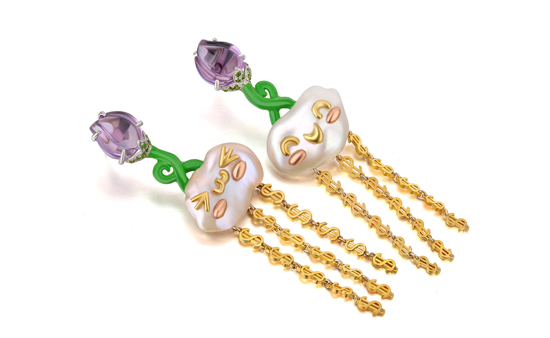
Tell us a bit about yourself.
My name is Beatrice and I am from Milan, but I have been studying BA Jewellery Design at Central Saint Martins in London for the last four years. I am very lucky to have found my passion so early in life because it truly is what I want to do in my life.
What was the inspiration for this piece?
My final collection ‘The Western Orient’, which was inspired by the increasing importance of the Asian market in today’s society, is a merge between the Orient’s heritage and the West’s strong consumer capitalist culture. The motifs embedded within the jewellery hold symbiotic connotations which function as a social critique of the globalisation in Eastern Asia.
This piece in particular is based more on the Western aspect as it focuses on the phenomenon of conspicuous consumption by means of stating the ‘price’ on the pearls.
What do you like most about pearls?
I like how timeless and elegant pearls are and the contrast that they create in my work, which uses very contemporary imagery. The pearls in my collection make my jewellery look more refined as they give it a lustrous classic undertone.
What’s your motto?
"Dream big"
CLAUDIA RICE
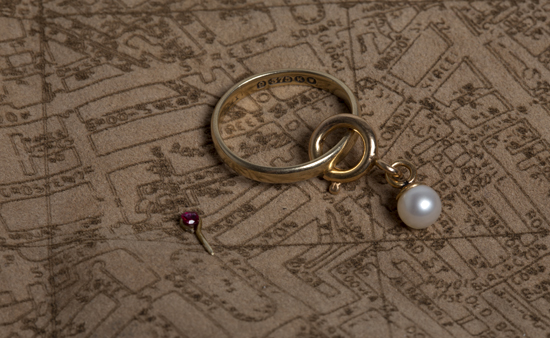
Tell us a bit about yourself.
My name is Claudia Rice and I have come into the craft of jewellery making and designing from having my father (and his father) in the jewellery business all his life as my influence. Starting as a watchmakers apprentice at 15, he was a traveling salesman for Mikimoto and Rosita Pearls during the 70s, setting up workshop in Hatton Garden to having his own shop in Marylebone high street, where I spent a lot of my time.
These surroundings have fed my desire to be part of that and continue my family trade.
What was the inspiration for this piece?
My inspiration stemmed from research into my dissertation on the subject of The History of Hatton Garden and my family connection with it. Becoming intrigued by maps of old London, discovering locations of ‘hidden treasures’, using an A-Z from 1969 and making a link with the modern technology of Google Maps.
What has been your best experience or moment at CSM?
Winning a design award from the Worshipful Company of Tin Plate workers.
What’s your motto?
“What goes around…”
EMILY WRIGHT

Tell us a bit about yourself.
I am a quietly confident person, I enjoy being creative and I don’t work well under pressure!
What was the inspiration for this piece?
The theme for my collection is reconnecting with those we have lost, through every day gestures, such as the simplicity of placing a necklace on a loved one.
What’s next for you?
Graduating (hopefully) and going into the world of work.
What do you like most about pearls?
I love the simplicity of pearls, they are glamorous in a beautiful yet understated way.
What has been your best experience or moment at CSM?
I have enjoyed the opportunities CSM has provided, and the opportunities we have had that we wouldn’t have gotten anywhere else.
Who is your favourite designer or artist and why?
I love the sculptures of Barbara Hepworth, I love the simplistic designs and the perfection in the lines.
What’s your motto?
"The best things in life aren’t things."
-
Erwin Blumenfeld at Somerset House
Erwin Blumenfeld at Somerset House
Just opened at Somerset House, London until 1st September is a celebration of the work of Erwin Blumenfeld, one of the most innovative fashion and advertising photographers of the twentieth century.
Featuring over ninety restored and coloured corrected prints of his work, the Blumenfeld Studio exhibition tells the extraordinary story of Blumenfeld's journey behind and in front of the lens.

Born in Berlin in 1897, Blumenfeld was given a camera at the age of 10 by his uncle, a gift that was to help shape his future life.
The young Blumenfeld experimented from an early age with the technical aspects of photography, using innovative darkroom techniques, solarisation and multiple exposures to develop his own trademark style - without the current temptations of Photoshop.
He initially focused on portraits and the nude female form, influenced in part by the work of Man Ray and the free expression of the Dadaist movement. The use of mirrors, silk, elaborate shadows, abstraction and angles also contributed to his work becoming noticed.
Moving to Paris in 1936, Blumenfeld was introduced by Cecil Beaton to French Vogue and was given a year's contract to work for the magazine.
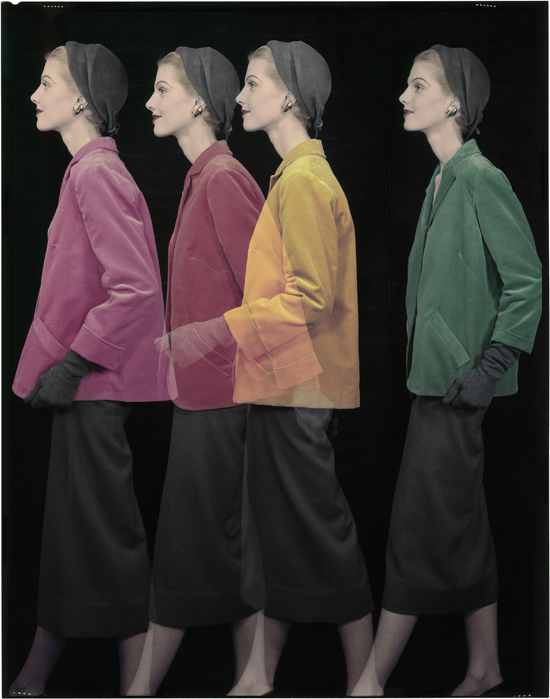
Following the outbreak of Second World War, and a period of internment, Blumenfeld successfully fled France with his family for America.
Fashion photography for Harper's Bazaar, Vogue and advertising campaigns for Elizabeth Arden, Dior and L'Oréal followed, securing Blumenfeld a near legendary reputation.
Even today Blumenfeld is known as the photographer for having the most Vogue covers, an achievement all the more remarkable for his persistence in refusing to compromise with the magazine's picture editors.
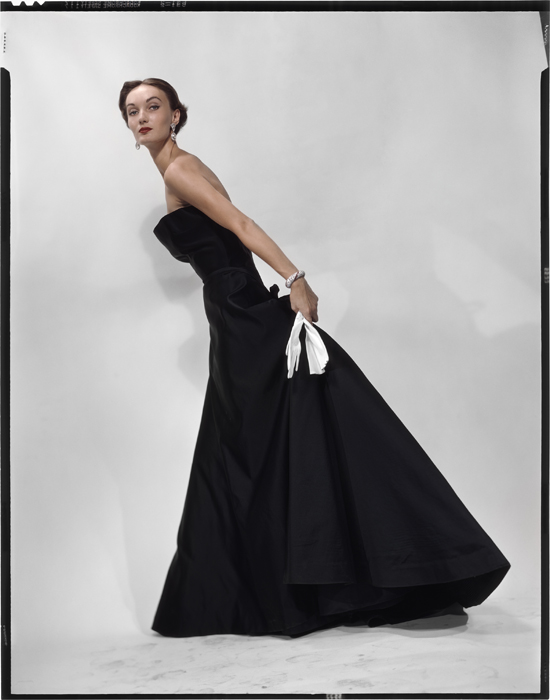
Celebrity models such as Grace Kelly and Audrey Hepburn contributed to the glamour, but the exhibition images demonstrate that throughout Blumenfeld continued to develop his work.
The confidently striking picture of a single eye, a beauty spot and a perfect pair of red lips for Vogue's March 1950 edition would be unknown on the front covers of today's magazines.
In a fitting tribute to Blumenfeld for Chanel, the Norwegian fashion photographer Solve Sundsbo commented "Blumenfeld was shooting 60 years ago what the rest of us will be shooting in 10 years time”.

Blumenfeld passed away in 1969 in typically unconformist style, believed to have deliberately forced a heart attack on himself by running up and down the Spanish Steps in Rome.
Following his death, an archive of some 8,000 prints were shared between his assistant and three children. Many of these have recently been faithfully restored and digitally mastered.
Blumenfeld left a stunning, much-copied and admired body of work that is surely as inspiring today as it was pioneering in the 1940s and 1950s.